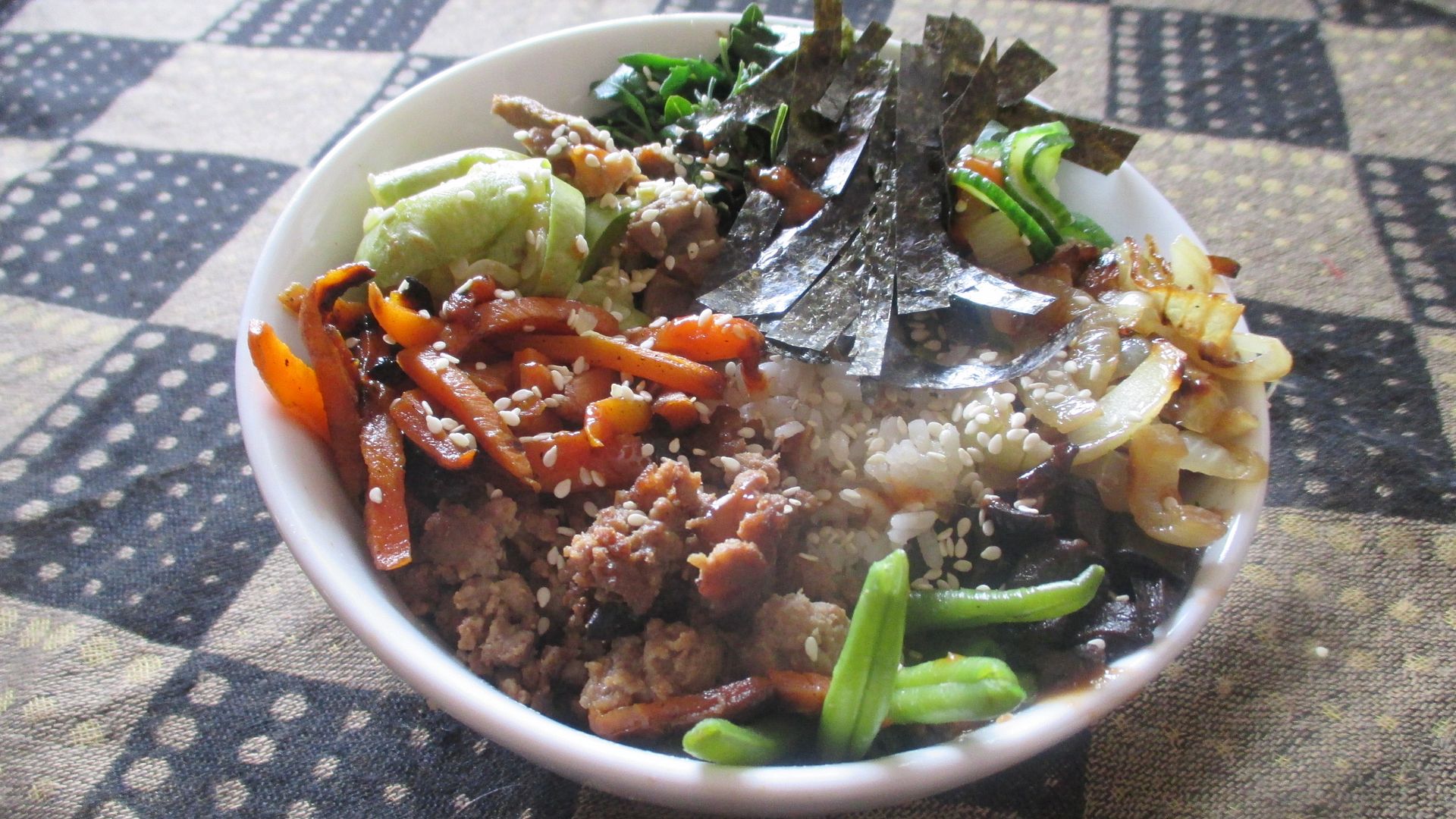 In a local group I’m in someone today asked if it is possible to spend $575 a month for a family of six. Of course everyone pointed them to me because I do that exact thing. Only I do so for $375-575 a month and that’s with eating gluten free and mostly processed food free, my eating paleo, etc. So yes, at least locally it is possible. Here’s how one can feed their family for pennies. Ok, not pennies exactly, but less than $1 per person per meal on average. In fact, if you follow these tips, you may very well be able to do it for 50 cents a person per meal….
In a local group I’m in someone today asked if it is possible to spend $575 a month for a family of six. Of course everyone pointed them to me because I do that exact thing. Only I do so for $375-575 a month and that’s with eating gluten free and mostly processed food free, my eating paleo, etc. So yes, at least locally it is possible. Here’s how one can feed their family for pennies. Ok, not pennies exactly, but less than $1 per person per meal on average. In fact, if you follow these tips, you may very well be able to do it for 50 cents a person per meal….
However there is one thing you have to know. While something may be possible it doesn’t mean that you’ll love doing it. You can’t have it all. To have the exact same diet and foods for less money usually takes more time. If you don’t have that extra time, to cut back on grocery costs you’ll need to change what you’re eating and you may find that hard. There is a saying “insanity is doing the same thing over and over and expecting different results.” That is true when it comes to grocery bills. If you want to keep your shopping habits and menu identical then there’s really no way to lower your bills. However, if you’re willing to make changes, at times drastic, then it is possible.
I’ll start off with tips on how to do that, with a focus on how to do so without spending so much extra time doing money saving things, followed by “extra credit” ideas for people with extra time and motivation to do things even more extremely, followed by frugal meal suggestions. I’m pointing out already that this isn’t necessarily the healthiest diet. There’s a reason I spent more money on health food items. And hopefully if your time or financial situation improves you can switch to healthier (still frugal) options, but when people are really struggling, fed is best. I’m going to make sure all the meals on the menu plan have produce and protein, etc. And no total junk other than white sugar, vegetable oil, and non whole grains.
Tips to Drastically Lower Your Family’s Grocery Bill
To lower your grocery bills, you’ll need to compromise.
Compromise on how you shop:
Don’t impulse buy. Buy because you need things. And actually need things, not wants disguised as needs. Many people swear by menu plans and strict shopping lists and they can be useful if you’re an impulse buyer. However. in general I don’t recommend them (unless they’re loose lists like “protein, cookable vegetables, salad vegetables, fruit, starch) because otherwise you may end up buying pricy items on your list and not stock up on sale items that you hadn’t put on the list. Instead, shop sales (see below) and buy what you need to feed your family, but ask yourself before buying each item “Do I need this or not?” and put it back if you do not. Or keep one or two “wants” per shop so you don’t feel deprived too much because mental health plays a part in whether or not a frugal lifestyle is sustainable.
Forget brand loyalty. Even if you like one brand more than another, go with the cheaper one if you need to make drastic changes. Eventually you probably will get used to the other brand.
Shop sales and bulk. Paying retail prices all the time can increase grocery prices tremendously. Buying items that you regularly use, and are either shelf stable or can be kept in the freezer, when you find them significantly lower in price than usual, can save money, providing that they are staples that you need, and you don’t eat them faster and end up spending more overall because you have them at home already. Bulk buying from special stores where you can buy 25-50 lbs at a time for staples can have significant savings. Though my tips in this post include using white flour instead of whole wheat, for example, locally you can buy whole wheat flour in bulk for nearly the same price as white flour.
When you shop this way you create a stockpile, which admittedly takes space to store it. But when there’s a will there’s a way. Our last home was 484 square feet for a family of six and I found room to store my stockpile. Yes it might have been an eye sore and I would have preferred a less cluttered look but we did what we had to do. If you think you don’t have room for a stockpile consider these options: on shelves in hallways, in bedrooms (maybe under beds), in your kitchen above your existing kitchen cabinets. You can find some place, I’m sure, to have at least some things stockpiled.
Shop around. I know that people will say that they don’t have time to shop around and I get it. I don’t either want to be spending all my time grocery shopping. But I do want to get each thing where it is cheapest. I try to not go to the corner grocery store unless it is having a sale and then only getting the sale items. Instead I just go grocery shopping anywhere between once every two weeks to twice in one week but usually averaging at once a week.
Each time I go grocery shopping, though, I try to rotate it so that I hit up each store every so often so I can stock up on what is cheaper there without needing to shop there weekly. One store that I shop at has gluten free bread and rice and legumes cheaper than any other. So I go there about once every month to month and a half for those items. Another store has cheaper chicken and cheese and tomato paste and most of my other staples other than produce. So I go there once every two or three weeks. And then every week or two I go to the place that sells produce most cheaply and buy what I need until the next time I can go. I’m definitely not spending my life shopping but still manage to get what is cheapest at each store. (If I run out before I’m scheduled to go to the store that is cheapest I will buy what I need from the more expensive store, but just enough to last me until I can get to the cheaper store, and then next time try to learn from that and buy more from the cheaper store so I don’t run out.)
Compromise on what you eat.
As I said earlier you can not expect to eat exactly the same as you always have if you want to cut your grocery bill significantly. Here’s some changes to make to your diet to make your bills much lower that don’t take too much extra prep time. You don’t need to do every single one of these changes or do them all the time but each time you do do these things you will have saved and it adds up over time.
Drink water. If you want to change things up make iced tea or lemonade or orangeade. If you want alcohol make your own alcohol from scratch. Of course water is cheaper than all those but these are significantly cheaper than bought drinks.
Cut down your meat consumption. Depending on how much you need to save money, I’d recommend either eliminating animal products entirely, having animal products only once or twice a week, or every other day. Alternatively use very little animal products in your meals and stretch with other cheaper vegan plant based proteins. Mixing ground meat with lentils or TVP is one way, stews and soups using mainly legumes but a little meat, chicken, or fish is another.
Switch to cheaper cuts. When you do eat animal products use cheaper ones. Wings are the cheapest per amount of meat here (but plug in your prices on my chart to see what is cheapest where you are). Here ground turkey is cheaper than ground beef. Frozen boneless white fish (tilapia and similar) works out cheaper than cans of tuna, and all those cheaper than salmon.
Ditch the dairy. Many people say that making vegetarian meals isn’t any cheaper since dairy is expensive. Yes. It is. Ditch the dairy. Or at least switch to cheaper ones. Homemade pudding is super simple. Homemade yogurt and homemade cottage cheese and homemade cream cheese is taking it up a notch but also isn’t hard. Milk isn’t so cheap but it’s cheaper than cheese, so use a milk and flour based white sauce instead of cheese (or combined with cheese to stretch it) in recipes when possible such as pizza, lasagna, mac and cheese, etc. Or use small amounts of dairy together with legumes (sour cream on bean or lentil tacos, white sauce on bean enchiladas, cheese in a lentil loaf, etc.)
Stick to legumes and not other vegan proteins. Often people say that vegan food isn’t even cheap, so it’s not worth cutting out animal products from a cost saving perspective. I beg to differ. Vegan meals can be cheap as long as they are based on dry legumes and not nuts or seeds. Don’t buy pricey tofu or tempe or vegan meat substitutes. Just do lentils and beans and chickpeas and peas as your main protein sources. Dry, not canned, since they are a fraction of the price of canned.
If you don’t have the time to cook beans every time you make a dish with them, put them in a crock pot or large pot with a lot of water and no salt, 2-4 lbs at a time, and cook until soft. Separate it into can sizes portions (2 cups) for use in meals. Don’t forget to price compare your legumes since, even dry, there can be significant differences in their price per pound. Black beans and kidney beans and butter beans here are pricier than chickpeas and white beans, and split peas and broad beans are cheapest.
Nuts are pricey and if you’re looking to cut costs they’re one of the first things that should go. If you do insist on nuts, buy what is cheaper per pound- locally walnuts are cheapest, almonds and cashews next up, while hazelnuts and pecans are super pricey. Replacing nuts with seeds such as sunflower or pumpkin seeds will lower costs. Depending on the recipes, sometimes to add a crunch you can add toasted green buckwheat.
Seasonal produce. Don’t just buy whatever produce you see. When shopping look around at the various prices of produce, calculate the average price per pound for vegetables (more or less) and the average price per pound for fruit (more or less) at the store. If something costs more than the average price, think twice about getting it. Try to buy produce that is cheaper than the average price, making the cheaper items being the bulk of your produce shopping and only buying the more expensive ones in limited amounts, if at all.
Embrace imperfections. Yes we all have the ideal tastes and textures we like, but when money is short, compromise is in order. Buying Persian rice instead of the more expensive jasmine, basmati, or risotto rice, or white instead of brown. Cheaper white flour pasta instead of the more expensive, higher quality pasta. Buy from the reduced rack at the grocery store, whether produce, meat, bakery items or dry goods, even if it looks a little less beautiful than the more expensive perfect stuff. When you have produce at home that you already bought, even if it gets a little wilted and not perfectly crispy, you can eat it- pickling and cooking work very well for wilting vegetables
Make from scratch when possible. Even if you’re shorter on time, there are some things that are just so much cheaper and as well as relatively east to make from scratch. Bread can be simple if you do 5 minute artisan bread, which can also be used as a base for pizza. Homemade tomato sauce takes less than two minutes to make for a fraction of the cost. Cakes take a few minutes but are significantly cheaper than bakery ones. Hot cereal is cheaper than processed cold cereal. And of course not buying pre chopped fruits and veggies.
Reduce waste. Use what you buy and dont toss leftovers. Use things up before they spoil. Revamp leftovers if you get bored of the same foods.
Expert level for extra credit points, if you have the time and energy to invest,
Forage wild produce to get things free.
Use exotic super cheap or even free foods like fish heads and other strange foods
Get free stuff from market, rescued from the trash.
Shop at scratch and dent stores for banged up dry goods.
Make every single thing you eat from scratch including condiments and pickles and snacks and spice mixes and crackers and tortillas.
Very Frugal Meal ideas:
Breakfast–
Hot cereal. Cheapest locally is cream of wheat made from semolina. Rice pudding is also cheap, especially when made from leftover rice. Oatmeal is more expensive but still cheap enough if purchased in the right stores. Serve with a splash of milk or a spoon full of peanut butter for cheap protein, or mix in a few eggs to the pot in rice pudding. Serve with chopped seasonal fruit.
Pancakes and waffles. These can be made with sour milk or vegan. Serve with homemade chocolate syrup instead of pricey maple syrup. For protein include some of the following in there: egg, milk, chickpea flour, tahihi, or peanut butter. Alternatively serve with a peanut butter based dipping sauce. (Peanut butter, water, and sugar- if using unsweetened peanut butter- boiled together until syrupy.)
Muffins. Make a large batch and freeze to have ready. To get protein cheaply in there, add in chickpea flour or mashed cooked chickpeas to the batch. Add grated or chopped seasonal fruit or veggies to round out the meal.
French toast with no egg or milk
Lunch: (Any supper can be served for lunch as well, but I’m writing easily portable meals here. A spill proof container makes nearly any food portable. Leftovers work great for lunch on the go.) Eat seasonal veggie spears along what is written here.
Pancakes.
Onigiri– Japanese rice balls- filled with terriyaki lentils or deboned chicken or cheapo fish
Sandwiches or wraps made from homemade breads and spread with:
- Hummus (can be chickpea based or from any other legumes. Homemade is super simple- just blend cooked legumes with lemon juice, salt, garlic, cumin, a little water and oil, and a little tahini if desired).
- Bean dip (like this one)
- Chickpea based mock tuna salad.
- Tahini.
- Peanut butter.
- Lentil spread.
- Spreadable cheap cheese especially if bought on sale.
- Tightwad’s Gazette’s lentil bulgur burritos.
- Stuffed tortillas
- Sabich sandwiches filled with Eggplant, hummus, pickles, hard boiled eggs, etc…
Supper:
Soups. Served with rice or cheap pasta or homemade bread to be more filling:
- Split pea soup (vegan)
- Bean or lentil based minestrone
- Tomato rice soup with either red lentils or milk as protein.
- Red lentil soup- Middle Eastern style or curried style.
- Broad bean soup.
- White bean and greens soup.
- Chicken soup made with cheap chicken parts (wings or frames) and seasonal vegetables, made in a variety of ways- made hot and sour with soy sauce (Asian style), curried, Yemenite style with hawaij, Italian style with tomato paste and herbs
Main dishes or one pot meals– serve over rice, mashed potatoes, pasta, or with bread, depending on the dish, as needed:
- Mac and “cheese” made with a milk and flour based white sauce and no actual cheese.
- Falafel (baked is faster) and fixings
- Colcannon (Irish mashed potatoes with milk and greens like cabbage)
- Bean or lentil based chili over rice/pasta/potatoes, or as part of chili cornbread skillet
- Cajun dirty rice with cheapo meat or legumes
- Fried rice or lo mein with deboned cheap chicken, lentils/beans/chickpeas or scrambled egg and seasonal vegetables
- Red lentil dal over rice
- Caribbean beans and rice
- Ethiopian lentil or split pea wot (stew) over rice or with flatbread
- Bean enchiladas
- Mock baked beans
- Honey mustard lentils
- Bibimbap made with legumes, eggs, or cheap meat or fish
- Mung bean stew– from Tajikistan
- Lentil meatballs
- Mung bean crepes
- Red lentil burgers
- Korean mung bean pancakes
- Pakistani black bean curry
- Egyptian broad beans
- Succotash– Native American stew
- Vegetarian sloppy joes
- Lentil and hot dog sauce
- Syrian mini mock meat pizzas
- Lentil vegetable risotto
- Thai fish curry– can be made with cheapo and/or deboned fish
- Egg curry
- Shakshouka– eggs poached in tomato sauce
- Rice with butternut squash and lentils
- Lentil vegetable curry
- Lentil bolognese sauce– either just lentils or mixed with ground meat or poultry
- Lentil and tomato dal
- Chicken lentil patties
- Lentil stuffed vegetables, such as stuffed peppers or zucchini or cabbage or eggplant
- Mujadarra– Syrian lentils with rice
- Delicious baked lentils
- Red lentil mash
- Pasta salad– add chickpeas or beans to make it a whole meal
- Homemade pizza with white sauce and seasonal veggies as toppings
- Lasagna with white sauce instead of cheese, and made with homemade noodles (3 cups whole wheat flour to one cup water, kneaded well and rolled thin- cut into sheets the width of your baking pan, as your lasagna noodles).
- Sweet and sour sauted cabbage (I add onion, sugar, lemon, salt, pepper and an apple and saute until sodt)
- Coleslaw
- Cabbage salad with lemon, oil, salt, and pepper
- Curried cabbage
- Cabbage salad with soy sauce
- Morrocan carrot salad (raw and cooked versions)
- Sweet and sour carrot salad (with lemon juice, sugar, cinnamin, and salt)
- Roasted carrots
- Sauted carmelized carrots
- Marinated cucumber salad
- Korean cucumber salad
- Stir fried cucumbers
- Baked cucumbers
- Russian vinegret salad
- Ratatouille
- Hungarian cabbage with noodles
- Roasted eggplant salad
Making Changes
However, if you’re in an extremely stressful financial situation, and you need to go all the way, to lower your bills as much as humanly possible, hopefully these tips will help you stretch your grocery budget.
How much do you currently spend on groceries each month for your family, and what size is it? (Please write answers converted to dollars if it isn’t already- thanks!) What is your goal for how much you want to be spending, or are you happy with how it is?
What tips would you give to people who want to or need to drastically cut their grocery bills?
Which of the tips I mentioned do you already do?
Are there any tips I mentioned that you think you’ll try, now that I mentioned them?
What are your favorite frugal meals to serve your family?





0 Responses
I live alone so I do things differently. I like to make rice pudding either with or without eggs and have it for breakfast and as dessert with other meals. I do the same with custard and cornstarch puddings. Also I make various impossible pies which make their own crusts and use them for breakfast and dessert. I don't do this all the time, but just to break the monotony. Of course I sweeten very lightly. I must eat gluten free so I use thin pancakes and corn tortillas for wraps. I also make "Appalachian tortillas" or hoe cakes which are mostly cornmeal and water, and fried like pancakes. They are good with jelly, etc. and folded to eat. Corn meal mush or polenta is good cooked, then when cooled and firm, fried.
Am I supposed to keep track of that stuff? We spend about $400/month on our family of 3 and our 2 dogs. They gotta eat too 🙂 That also includes toiletries and paper goods!
Fantastic post, thank you! We're a family of 3. Every 2 months, we drop $100 on groceries to stock up. Weekly, we spend $10-40. This week I spent just under $13 and we eat well. I do believe that getting an affordable splurge or two keeps everyone happy. My meal plans are based on what we have, but are subject to change. I make a plan, then below I list a dozen or so other meals that can be made. If what was planned doesn't sound good on the day of, I replace it with one of the alternative options.
I spend about $400 a month on our family of 5, which excludes one lunch and one dinner a week with relatives. We live in a major city on the East Coast of the US.
Seeing Max and "cheese" on the list brought back memories of when I knew the cupboard was truly bare as a child. If we were lucky, there was a little ketchup to squirt to bring out a little flavor. It wasn't often, but when stretching had to be done, my mom did it. I try to rein in my shopping, even though I know our income is higher than most, because we have other priorities, including donating to local food bank.Looking back, I never felt poor as a child, though we clearly were by most standards, but my parents just dealt with it, not wishing for more than we had, and were generous in their less poor times.
Thank you for such a detailed post Penny. A caveat I want to mention is what one culture considers waste, another considers a delicacy. My neighborhood is mostly East Asian and the markets in the area all SELL the fish heads instead of giving them away (and sometimes at a higher price than the filets!).
Yeah, I don't think our Asian market gives away fish heads either. But they are yummy 🙂
Another great post…thanks.
Sadly, I have no clue how much I spend for husband and myself, maybe $500-600 a month in Georgia, USA. I do have a fully stocked pantry & freezer and could probably go about a month or two without shopping for anything but the basics (bread & milk).
One thing that has finally sunk into my head is that every 6 weeks, the same items go on sale. Last time I stockpiled my toiletry & laundry items enough for 6 months. My goal now is to purge because I bought other stuff I needed (clothing, toaster, coffee maker, mandoline, sofa, mattresses) and I plan to take the food shopping savings to help pay off the debt I incurred. Also, I plan to make some serious portion control eating habits in my life to help drop pounds. I eat WAY too much, even if it is healthy.
I have lived the cheap life before and I know I can do it again, only this time more healthy, less meat, less food consumption and no Koolaid.
Also, I don't know if they have coupons and cash back apps like Ibotta where you at, but they help save much money. And I also try to grow my own veggies in the summer using leftover parts of veggies, like celery for example. I want to learn to forage but there are no classes anywhere near me and way too much ground pollution. But I have faith.
Oh and tonight I had a frugal meal… salad, then pasta with spaghetti sauce. Cost around $2 a person which is great for me. Everything I bought was on sale with a coupon. And I really wanna try some of the cucumber dishes since they are always 50 cents each and yet eating one is an entire meal.
My best tip is portion control. 1 lb of lean ground beef goes a long way when you realize you should only be eating about 3 oz of it per meal. Worth the extra $2 a lb to cut out all that fat and still eat healthy. Plus, if you cook it ahead of time with some onion and parsley, you can control how much is actually going into the dish your using it on, freeze the remainder.
Vanessa that sounds fantastic! I would love to know what your weekly/2 month grocery list looks like.
excellent, inspiring post, love the level of detail, I think it's key to track how much we spend, I know we have too much food waste, and I shudder to think how much my dear husband spends on chips and other salty snacks
We spend $80 per month for two people. I'm hoping to get it down to $500/person/year in 2017. Using a price list helps a lot, and cooking with cheaper food (chicken vs. beef) will go a long way, as Penny said. I like to use the coupons and rebates to buy things we wouldn't normally eat, like avocados or pineapple. I think we have a decent amount of meat, dairy, produce etc. for $20 per week. It's all about stockpiling when you find a deal. No-frills stores like Aldi or Save-a-lot and great places to buy milk or produce on a weekly basis. We are in a rural area, so I imagine it is cheaper than some places.